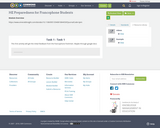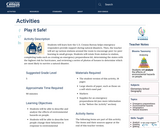
https://www.emeraldinsight.com/doi/abs/10.1108/09513540810844530?journalCode=ijem
- Subject:
- Applied Science
- Material Type:
- Module
- Author:
- Bibhya Sharma
- Date Added:
- 07/05/2018

https://www.emeraldinsight.com/doi/abs/10.1108/09513540810844530?journalCode=ijem

Learning ObjectivesFlorida is situated in what is known as the "hurricane alley." This region starts from the west coast of Africa to Florida, and up the Carolinas. This region is prone to tropical storms and hurricanes due to the warm water temperatures. The objective of this lesson is to offer tips and strategies without causing fear to elementary-level students so that students they can be prepared for the event of a hurricane ahead of time.

This sequence of instruction was developed in the Growing Elementary Science Prjoject to help elementary teachers who were working remotely. We developed a short storyline that ties together a few sessions to help explore a specific concept. We tried to include some activities that honored and included the student’s family and experience, and some that included the potential for ELA learning goals. The book “Storm is Coming!” introduces students to the idea of severe weather. Students observe a time-lapse video of a hail storm. Students interview a family member about a memorable weather event and what that person did to prepare and stay safe. Students explore the implications of all of their interviews. Students make plans for how they can prepare for future weather events, including an Engineering Design exercise. It is part of ClimeTime - a collaboration among all nine Educational Service Districts (ESDs) in Washington and many Community Partners to provide programs for science teacher training around Next Generation Science Standards (NGSS) and climate science, thanks to grant money made available to the Office of the Superintendent of Public Instruction (OSPI) by Governor Inslee.

Students will learn how the U.S. Census Bureau helps emergency responders provide support during natural disasters. Then, the teacher will set up various stations around the room to encourage peer-to-peer learning in small groups. Students will rotate from station to station, completing tasks such as creating an emergency preparedness kit, determining the states with the highest risk for hurricanes, and reviewing a series of photos of houses to determine which are most likely to survive a natural disaster.